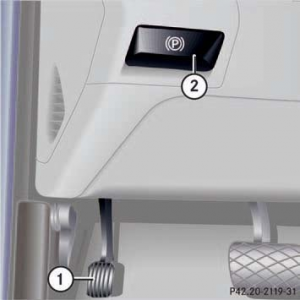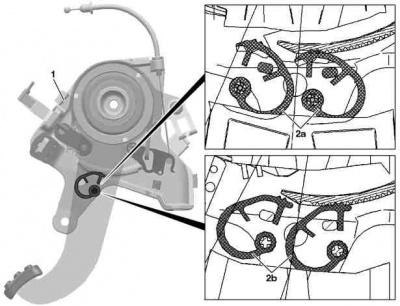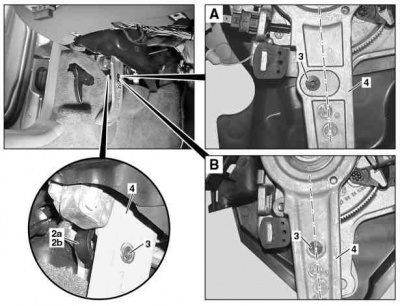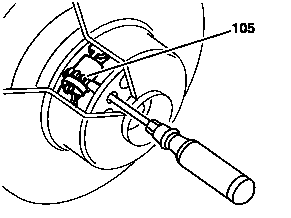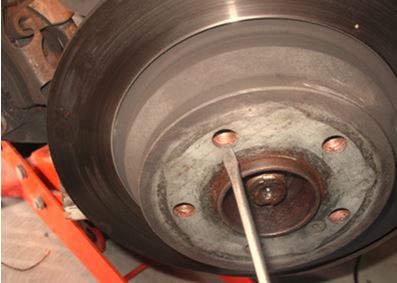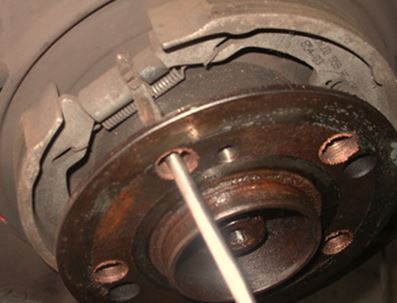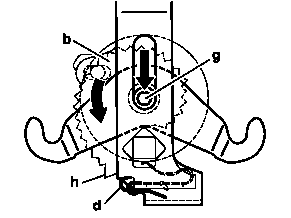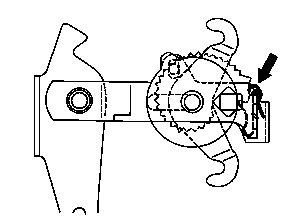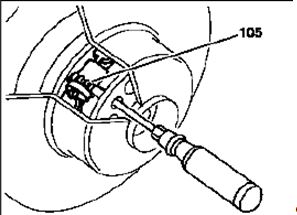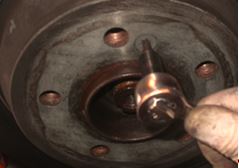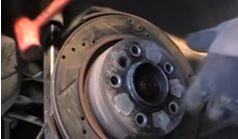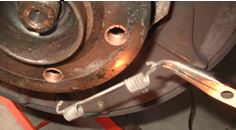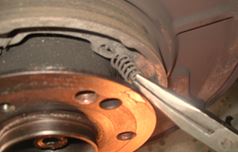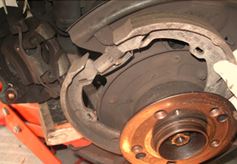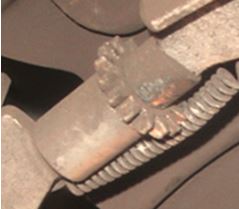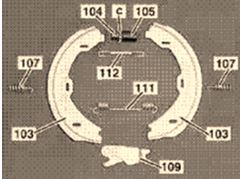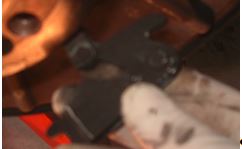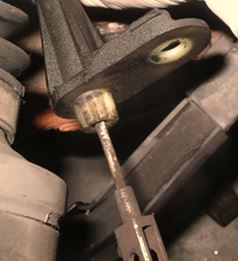Parking brake: Difference between revisions
m (Pokseva moved page WIS 42.20 Parking Brake to Parking brake) |
(parking brake sections added) |
||
| Line 18: | Line 18: | ||
The indicator lamp in the instrument cluster goes out. | The indicator lamp in the instrument cluster goes out. | ||
== | == Friction brake pedal assembly / parking brake == | ||
=== | <!-- GF42.20-P-1000A Friction brake pedal assembly / parking brake, function 18.3.08 | ||
MODEL 129, 140, 163, 202, 208, 209, 210, 211, 215, 220, 240 | |||
MODEL 203, 230 up to Model Year 08 /modification year --> | |||
{| | |||
| | |||
* 1 - Brake drum | |||
* 2 - Band spring | |||
* 3 - Gearing | |||
* 4 - Notch | |||
* 6 - Spring | |||
* 71 - Pedal assembly | |||
* 75 - Brake pedal | |||
|[[File:W220_parking_brake_pedal_assembly.png|400px]] | |||
|} | |||
Brake pedal (75) holds the parking brake in the pressed position and avoids loose knock. | |||
A brake drum (1) is cast into the brake pedal (75). | |||
A pre-compressed flat spiral spring (2) is wound around this drum (1). | |||
The flat spiral spring is pre-compressed by a spring (6). | |||
If the brake pedal (75) is pressed, the force of friction of the flat spiral spring (2) | |||
continuously holds the brake pedal (75). | |||
When the pedal is pressed the familiar adjusting noise is passed on via the toothing (3) and the notch (4). | |||
== Parking brake pedal assembly modified == | |||
<!-- BT42.20-P-0510-01A | |||
Parking brake pedal assembly modified | |||
MODELS 129, 140, 163, 202, 203, 208, 209, 210, 211, 215, 220, 230, 240 | |||
--> | |||
{| | |||
| | |||
Phased in as of approx. 09/2002 a modified design of parking brake pedal systems (1) have been fitted. | |||
The new version of the pedal assembly (1) has a pulled notch (2a) instead of a pushed notch (2b) as previously. | |||
This results in different values for the adjustment of the parking brake. | |||
On account of the successive production launch and the possibility that in the case of repair, that old replaces new or new | |||
replaces old, on '''each''' vehicle, the version of the pedal assembly (1) is determined before the parking brake is adjusted. | |||
|[[File:W220_parking_brake_assembly_modified_1.jpg|400px]] | |||
|} | |||
{| | |||
| | |||
The new and previous version can be distinguished by the position of the shaft journal (3) in the pedal lever (4). | |||
Moreover the notches (2a, 2b) differ in color. | |||
* A - Late type: The shaft journal (3) of detent (2a) is mounted offset from the pedal lever center. Color of notch (2a): light gray | |||
* B - Previous version: The shaft journal (3) of the notch (2b) is mounted centrally in the pedal lever (4). Color of notch (2b): black | |||
|[[File:W220_parking_brake_assembly_modified_2.jpg|400px]] | |||
|} | |||
== Adjusting parking brake == | |||
<!-- AR42.20-P-0540I Adjusting parking brake 18.11.97 | |||
MODELS 215, 220 (except 215.379, 220.179) --> | |||
[[File:W220_adjusting_parking_brake.png]] | |||
[[File:W220_Adjust_the_parking_brake_shoes.JPG|400px|]] | |||
[[File:W220_Internal_View_of_Parking_Brake_Thumbwheel.JPG|400px]] | |||
# Check version of parking brake pedal assembly ''(pulled vs pushed detent)'' | |||
# Operate parking brake pedal and check pedal travel of parking brake pedal. If the pedal travel is not within the tolerance range, adjust parking brake. | |||
# Lift vehicle with lifting platform until the wheels are clear | |||
# Pre-tension automatic cable slack adjuster | |||
# Remove rear wheels. | |||
# Using a suitable tool, turn the adjusting wheel (105) until the brake shoes touch the brake drum and the rear wheel no longer turns. Adjustment direction for applying the brake shoes: Right side: Turn the adjusting wheel (105) from the bottom upwards. Left side: Turn the adjusting wheel (105) from the bottom upwards. | |||
# Turn back the adjusting wheel (105) until the rear wheel can be turned completely freely. When slackening the adjusting wheels ensure that both sides are turned back by the same number of teeth (10 teeth). | |||
# Relieve load on automatic cable slack adjuster. | |||
# Actuate parking brake pedal several times | |||
# Check that the rear wheels can turn freely | |||
# Mount rear wheels | |||
* Actuating force on parking brake pedal: N 170 (-50/+70) | |||
* Notches through which the parking brake pedal must be depressed: 1 (pedal assembly with pulled dent) | |||
* Notches through which the parking brake pedal must be depressed: 5 (pedal assembly with pushed detent) | |||
=== Pre-tension automatic cable slack adjuster === | |||
<!-- AR42.20-P-0520-01A Pre-tension automatic cable slack adjuster --> | |||
[[File:W220_pretention_automatic_cable_slack_adjustment.png]] | |||
Turn detent eccentric bolt (g) to the left using the Allen wrench (approximately half a turn) | |||
and simultaneously push backwards in slot until the spring-loaded detent eccentric (b) | |||
engages with the raised section (h) in the holddown clip (d). | |||
=== Relieve load on automatic slack adjuster === | |||
<!-- AR42.20-P-0520-02A Relieve load on automatic slack adjuster --> | |||
[[File:W220_Relieve_load_on_automatic_slack_adjuster.png]] | |||
Lift center holddown clip (arrow) using a screwdriver so that the cable slack adjuster sets itself automatically. | |||
===Unload Automatic Cable Slack Adjuster - Parking Brake=== | |||
Release the Parking Brake Cable Automatic Tensioning Mechanism from underneath the car. This releases any tension in the parking brake cables and the cables may even be taken off the Tensioning Mechanism if required. '''TIP''': It can take several attempts to get this right. The trick is to rotate the detent eccentric bolt (g) counter clockwise when viewed from underneath until it clicks into place into the hold down clip spring (d). | |||
#:[[File:W220_Relax_Parking_Brake_Cable_Automatic_Tensioning_Mechanism.JPG|700px|center]] | |||
===Preload Automatic Cable Slack Adjuster - Parking Brake=== | |||
Using a flat bladed screw driver push in the direction of the arrow to release the hold down clip (d) on the brake automatic cable slack adjuster. This tensions both parking brake cables and the cable slack adjuster will set itself automatically. | |||
[[File:W220_Preload_Brake_Automatic_Cable_Slack_Adjuster.JPG|300px|center]] | |||
[[File:W220_Adjusting_Parking_Brake_Center_Hold_Down_Clip.JPG|300px|center]] | |||
{| | |||
|{{#ev:youtube|https://www.youtube.com/watch?v=o5aH0iRlKHI|320|left|Parking brake automatic cable slack adjustment.|frame}} | |||
|} | |||
#Release Parking Brake | #Release Parking Brake | ||
#Unload Automatic Cable Slack Adjuster - Parking Brake See below. | #Unload Automatic Cable Slack Adjuster - Parking Brake See below. | ||
| Line 25: | Line 125: | ||
#Rotate the right side wheel so that the access hole (any wheel bolt hole) is positioned at 11:00 o’clock position to provide access to the parking brake thumbwheel (ratchet mechanism). (For the left side wheel the access hole (wheel bolt hole) is positioned at the 1:00 o’clock position. | #Rotate the right side wheel so that the access hole (any wheel bolt hole) is positioned at 11:00 o’clock position to provide access to the parking brake thumbwheel (ratchet mechanism). (For the left side wheel the access hole (wheel bolt hole) is positioned at the 1:00 o’clock position. | ||
#Note the correct angle for the wide bladed screw driver tip. | #Note the correct angle for the wide bladed screw driver tip. | ||
#: | #: | ||
#Shine a flashlight into the hole (or use a video inspection camera) to see what the tooth of the thumbwheel inside looks like. | #Shine a flashlight into the hole (or use a video inspection camera) to see what the tooth of the thumbwheel inside looks like. | ||
#Insert a flat blade screwdriver through the hole and catch between two teeth. | #Insert a flat blade screwdriver through the hole and catch between two teeth. | ||
#Adjust the parking brake shoes to provide maximum clearance. The next Figure shows an the internal View of Parking Brake Thumbwheel. This is what you are trying to do. | #Adjust the parking brake shoes to provide maximum clearance. The next Figure shows an the internal View of Parking Brake Thumbwheel. This is what you are trying to do. | ||
#: | #: | ||
#:[[File:W220_Adjusting_Parking_Brake.JPG|300px|center]] | #:[[File:W220_Adjusting_Parking_Brake.JPG|300px|center]] | ||
#Start moving the screwdriver handle upward (tip of the screwdriver moving downward) to turn the adjusting wheel clockwise, do about two turns and turn the rotor to see if there is a slight resistance turning the rotors and adjust more or less depending on the resistance. | #Start moving the screwdriver handle upward (tip of the screwdriver moving downward) to turn the adjusting wheel clockwise, do about two turns and turn the rotor to see if there is a slight resistance turning the rotors and adjust more or less depending on the resistance. | ||
| Line 35: | Line 135: | ||
#Finally Preload Brake Automatic Cable Slack Adjuster. See below. | #Finally Preload Brake Automatic Cable Slack Adjuster. See below. | ||
==Replacing Parking Brake== | |||
#Unload Parking Brake Automatic Cable Slack Adjuster See below. | #Unload Parking Brake Automatic Cable Slack Adjuster See below. | ||
#Take off the rear wheel, observe how freely the rotor turns while turning it by hand. | #Take off the rear wheel, observe how freely the rotor turns while turning it by hand. | ||
#Rotate the right side wheel so that the access hole (any wheel bolt hole) is positioned at 11:00 o’clock position to provide access to the parking brake thumbwheel (ratchet mechanism). (For the left side wheel the access hole (wheel bolt hole) is positioned at the 1:00 o’clock position. | #Rotate the right side wheel so that the access hole (any wheel bolt hole) is positioned at 11:00 o’clock position to provide access to the parking brake thumbwheel (ratchet mechanism). (For the left side wheel the access hole (wheel bolt hole) is positioned at the 1:00 o’clock position. | ||
#Note the correct angle for the wide bladed screw driver tip. | #Note the correct angle for the wide bladed screw driver tip. | ||
#Shine a flashlight into the hole (or use a video inspection camera) to see what the tooth of the thumbwheel inside looks like. | #Shine a flashlight into the hole (or use a video inspection camera) to see what the tooth of the thumbwheel inside looks like. | ||
#Insert a flat blade screwdriver through the hole and catch between two teeth. | #Insert a flat blade screwdriver through the hole and catch between two teeth. | ||
#Adjust the parking brake shoes to provide maximum clearance. The next Figure shows an the internal View of Parking Brake Thumbwheel. This is what you are trying to do. | #Adjust the parking brake shoes to provide maximum clearance. The next Figure shows an the internal View of Parking Brake Thumbwheel. This is what you are trying to do. | ||
#Rotate the parking brake thumbwheel (ratchet mechanism) downwards (screw driver handle upwards) to release the brake to its maximum clearance. | #Rotate the parking brake thumbwheel (ratchet mechanism) downwards (screw driver handle upwards) to release the brake to its maximum clearance. | ||
#Remove the Torx screw holding brake disk to rear axle shaft flange. | #Remove the Torx screw holding brake disk to rear axle shaft flange. | ||
| Line 75: | Line 168: | ||
#:[[File:W220_Remove_the_Parking_Brake_Cable.JPG|300px|center]] | #:[[File:W220_Remove_the_Parking_Brake_Cable.JPG|300px|center]] | ||
#Reinstall in reverse order remembering to Preload Brake Automatic Cable Slack Adjuster. See below. | #Reinstall in reverse order remembering to Preload Brake Automatic Cable Slack Adjuster. See below. | ||
Revision as of 20:20, 1 October 2018
Description - Parking Brake
When parked on an incline, gear shift position P alone may not prevent your vehicle from moving, possibly hitting people or objects. Always set the parking brake in addition to shifting to position P. TIP: On steep slopes, turn the front wheels towards the curb.
- Parking brake pedal
- Parking brake release handle
Step firmly on parking brake 1.
When the engine is running, the indicator lamp in the instrument cluster illuminates.
Release the parking brake by pulling handle 2.
The indicator lamp in the instrument cluster goes out.
Friction brake pedal assembly / parking brake
|
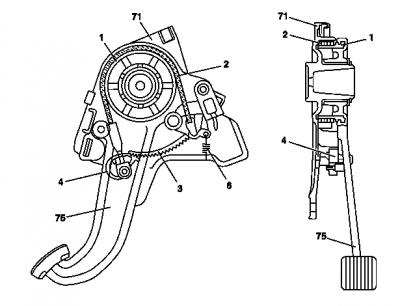
|
Brake pedal (75) holds the parking brake in the pressed position and avoids loose knock.
A brake drum (1) is cast into the brake pedal (75). A pre-compressed flat spiral spring (2) is wound around this drum (1). The flat spiral spring is pre-compressed by a spring (6). If the brake pedal (75) is pressed, the force of friction of the flat spiral spring (2) continuously holds the brake pedal (75). When the pedal is pressed the familiar adjusting noise is passed on via the toothing (3) and the notch (4).
Parking brake pedal assembly modified
Adjusting parking brake
- Check version of parking brake pedal assembly (pulled vs pushed detent)
- Operate parking brake pedal and check pedal travel of parking brake pedal. If the pedal travel is not within the tolerance range, adjust parking brake.
- Lift vehicle with lifting platform until the wheels are clear
- Pre-tension automatic cable slack adjuster
- Remove rear wheels.
- Using a suitable tool, turn the adjusting wheel (105) until the brake shoes touch the brake drum and the rear wheel no longer turns. Adjustment direction for applying the brake shoes: Right side: Turn the adjusting wheel (105) from the bottom upwards. Left side: Turn the adjusting wheel (105) from the bottom upwards.
- Turn back the adjusting wheel (105) until the rear wheel can be turned completely freely. When slackening the adjusting wheels ensure that both sides are turned back by the same number of teeth (10 teeth).
- Relieve load on automatic cable slack adjuster.
- Actuate parking brake pedal several times
- Check that the rear wheels can turn freely
- Mount rear wheels
- Actuating force on parking brake pedal: N 170 (-50/+70)
- Notches through which the parking brake pedal must be depressed: 1 (pedal assembly with pulled dent)
- Notches through which the parking brake pedal must be depressed: 5 (pedal assembly with pushed detent)
Pre-tension automatic cable slack adjuster
Turn detent eccentric bolt (g) to the left using the Allen wrench (approximately half a turn) and simultaneously push backwards in slot until the spring-loaded detent eccentric (b) engages with the raised section (h) in the holddown clip (d).
Relieve load on automatic slack adjuster
Lift center holddown clip (arrow) using a screwdriver so that the cable slack adjuster sets itself automatically.
Unload Automatic Cable Slack Adjuster - Parking Brake
Release the Parking Brake Cable Automatic Tensioning Mechanism from underneath the car. This releases any tension in the parking brake cables and the cables may even be taken off the Tensioning Mechanism if required. TIP: It can take several attempts to get this right. The trick is to rotate the detent eccentric bolt (g) counter clockwise when viewed from underneath until it clicks into place into the hold down clip spring (d).
Preload Automatic Cable Slack Adjuster - Parking Brake
Using a flat bladed screw driver push in the direction of the arrow to release the hold down clip (d) on the brake automatic cable slack adjuster. This tensions both parking brake cables and the cable slack adjuster will set itself automatically.
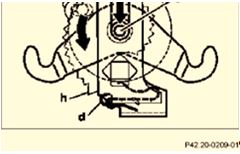
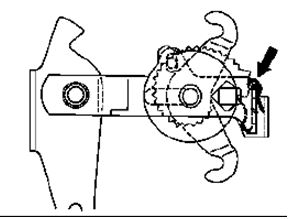
- Release Parking Brake
- Unload Automatic Cable Slack Adjuster - Parking Brake See below.
- Take off the rear wheel, observe how freely the rotor turns while turning it by hand.
- Rotate the right side wheel so that the access hole (any wheel bolt hole) is positioned at 11:00 o’clock position to provide access to the parking brake thumbwheel (ratchet mechanism). (For the left side wheel the access hole (wheel bolt hole) is positioned at the 1:00 o’clock position.
- Note the correct angle for the wide bladed screw driver tip.
- Shine a flashlight into the hole (or use a video inspection camera) to see what the tooth of the thumbwheel inside looks like.
- Insert a flat blade screwdriver through the hole and catch between two teeth.
- Adjust the parking brake shoes to provide maximum clearance. The next Figure shows an the internal View of Parking Brake Thumbwheel. This is what you are trying to do.
- Start moving the screwdriver handle upward (tip of the screwdriver moving downward) to turn the adjusting wheel clockwise, do about two turns and turn the rotor to see if there is a slight resistance turning the rotors and adjust more or less depending on the resistance.
- Once the rotor will not turn, backoff the thumbwheel adjustment about five notches until the rotor will turn freely. TIP: Both sides should be backed off the same amount.
- Finally Preload Brake Automatic Cable Slack Adjuster. See below.
Replacing Parking Brake
- Unload Parking Brake Automatic Cable Slack Adjuster See below.
- Take off the rear wheel, observe how freely the rotor turns while turning it by hand.
- Rotate the right side wheel so that the access hole (any wheel bolt hole) is positioned at 11:00 o’clock position to provide access to the parking brake thumbwheel (ratchet mechanism). (For the left side wheel the access hole (wheel bolt hole) is positioned at the 1:00 o’clock position.
- Note the correct angle for the wide bladed screw driver tip.
- Shine a flashlight into the hole (or use a video inspection camera) to see what the tooth of the thumbwheel inside looks like.
- Insert a flat blade screwdriver through the hole and catch between two teeth.
- Adjust the parking brake shoes to provide maximum clearance. The next Figure shows an the internal View of Parking Brake Thumbwheel. This is what you are trying to do.
- Rotate the parking brake thumbwheel (ratchet mechanism) downwards (screw driver handle upwards) to release the brake to its maximum clearance.
- Remove the Torx screw holding brake disk to rear axle shaft flange.
- Remove the Brake Disk to gain access to the parking brake mechanisms. TIP: If you haven’t previously used anti-seize grease on the hub you may have to tap the disc with a rubber mallet.
- Remove the Parking Brake Lower Retracting Spring. This requires a fair bit of effort but it is possible with normal 45º long nose pliers.
- Remove the Brake Shoe Retaining Springs. Remove the two rear brake shoe retaining springs by pushing them inwards and twisting 90º.
- Note the Retaining Springs Alignment for Re-installation. TIP: The installed position of the retaining springs is such that the hook end is facing radially inwards and pointing directly at the centre of the wheel hub.
- Remove the Parking Brake Shoes and Adjusting Mechanism over the Wheel Hub.
- Note the Orientation of the Parking Brake Adjusting Thumbwheel. TIP: The thrust piece (shorter length) is towards the front of the vehicle on both sides. The next Figure shows the right side wheel.
- Store the Parking Brake. TIP: Store the parking brake out of the way maintaining the correct positioning for each component to aid in re-installation.
- Remove the Parking Brake Expansion Lock. TIP: Carefully remove the parking brake expansion lock (actuating mechanism) and note the orientation. The hooked end of the Expansion Lock (109) is towards the front of the vehicle on both sides. The next Figure shows the right side wheel.
- Remove the Parking Brake Cable. TIP: Remove the bolt and withdraw the parking brake cable and place out of the way.
- Reinstall in reverse order remembering to Preload Brake Automatic Cable Slack Adjuster. See below.
